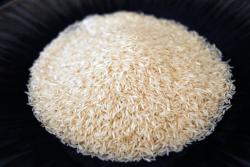‘When this rice is done, the grains should be standing on end, begging you to eat them, almost dancing around the pan’, declares Arun Kapil, himself doing a fair spot of the latter as he jigs about eulogising about Green Saffron‘s AAA Vintage  Basmati rice. He and Carom‘s head chef, Balaji Balachander have got a biriyani on the bubble, to demonstrate why this particular grain strain is just so superior.
Basmati rice. He and Carom‘s head chef, Balaji Balachander have got a biriyani on the bubble, to demonstrate why this particular grain strain is just so superior.
Arun is the animated founder of Ireland-based family company Green Saffron. With an Anglo-Indian heritage and a determination to reintroduce us Brits to the intense, fresh spices which whizzed over during the height of the spice trade, he’s heavily hands-on with sourcing, purchasing and blending the masalas Green Saffron is fast becoming so renowned for. And it’s not just with Indian consumers- Joel Robuchon, Heston Blumenthal and Richard Corrigan are all big fans of the brand.
The unmistakable smoky, alluring scent of Basmati is pervading our nostrils as Arun describes the arduous 14-month trawl to discover the perfect rice strain in the Himalayan foothills. Although the Dehradun region is classically synonymous with Basmati production, it essentially now belongs to the multinational companies, and no longer holds quite such a cache. By contrast, Green Saffron‘s rice comes from the Taraori region in the Northern state of Harayana.
Chef Bala is a fan, declaring Basmati to be like’a beautiful girl you are admiring’. He happily pays the premium for Green Saffron‘s rice, but, since well-aged grains have double the yield of inferior products, he gets his money’s worth. Ageing the grains for up to three years between layers of salt allows the taste to become sweeter and more intense, with a more pronounced bite. Neither Bala nor Arun believe it necessary to rinse their rice prior to cooking- a notion to which the formidable Cyrus Todiwala will attest.
Two bowls of rice are passed around- even dry, the difference is immediately apparent. Green Saffron‘s sample is a creamier hue, with longer, thicker grains. Due to the minimal processing, well-aged Basmati holds the same GI value as brown rice, and this particular brand uses neem leaves- known for their antibacterial effect- as a natural storage preservative. Together with the known health properties of the spices in the garam masala Bala’s mixing with the rice, we’re going to be in rude health tonight.
Bala is preparing his biriyani in the Southern style known as’Nizwad’- a speciality of Andra Pradesh’s capital city,  Hyderabad- differentiated from its Northern Moghul counterpart by lighter, more fragrant spicing and by cooking the grain and meat together rather than merely combining to serve. The dish is assembled in layers and cooked’dum’- allowed to steam under a sealed dough crust. Bala tops his rice with puff pastry, then pops the pot in the oven to allow the flavours to mingle.
Hyderabad- differentiated from its Northern Moghul counterpart by lighter, more fragrant spicing and by cooking the grain and meat together rather than merely combining to serve. The dish is assembled in layers and cooked’dum’- allowed to steam under a sealed dough crust. Bala tops his rice with puff pastry, then pops the pot in the oven to allow the flavours to mingle.
The proof, they say, is in the pudding- or, as here, the biriyani. Despite the dishes’ high aromats and thick dollops of the traditional accompaniment of cooling raita, Green Saffron‘s Basmati retains a voice of its own- and manages to shout pretty loudly. To many, rice is an everyday, dependable store-cupboard staple- but Arun’s on a mission to convince us it can be rather extraordinary. Well done, pal- I may not be a top chef, but you can definitely chalk yourself up one more convert.
To find out about Green Saffron and purchase selected products, visit http://www.greensaffron.com
Balaji Balachandar hosts Carom‘s Rice Masterclasses as part of the Curry Club’s regular programme of events. The next date is Wednesday 10th October and costs £35pp, to include welcome drink, demo, goodie bag and a three-course sit-down dinner. For more information, visit http://www.meza-soho.co.uk. Carom at Meza, 100 Wardour St, W1F 0TN
